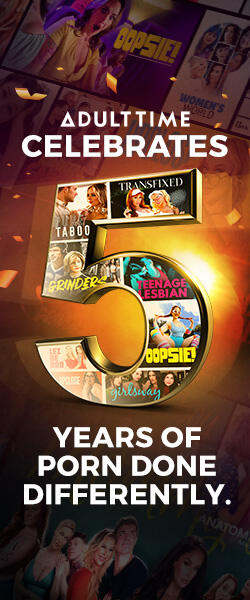Thursday saw the debut of the next stage in high-tech video conventions: The HD Expo, which gathered nearly 60 manufacturers, manufacturers' reps and suppliers to the Beverly Hills Hotel, where content producers and shooters from across the U.S. got to ogle and examine the newest production equipment, from cameras to servers to editing systems to duplicators to lighting panels.
And not too surprisingly, almost every exhibitor was aware that the adult industry is gearing up to be a major market for their products.
"We know your industry tends to be early-adopters," recognized Tim Smith, a rep for Canon USA, which had several HD cameras on display. "Your industry is what created VHS anyway, and no matter what content you're delivering, it's going to be all about HD no matter what the content is, whether it be Disney or you guys, so at some point, everybody's going to be shooting high-def for everything."
But since this was a manufacturers' show, there were no adult exhibitors, though we did spot a few industry techies in the crowd, including educational vid producer Dr. Michael Perry, who (like this reporter) was somewhat lost among the jargon-filled conversations taking place at every booth.
Besides Canon, nearly all the major HD camera manufacturers were present, including Sony, Panasonic and JVC, showing cameras that ranged from tiny handhelds costing just over $1000 – for instance, Canon's HP20 – to Sony's PDW-F350, which, discounted, still sells for just under $25,000 ... and that's without all the bells and whistles.
For adult videographers, Canon offers three main choices: The XH A1 and XH G1, both of which offer a fixed 20-to-1 stabilized zoom in a light-weight, easily maneuverable unit, with the G1 offering additionally a "Professional JackPack" with HD SCI genlock and timecode connection ports, and both selling for under $5000; and the XL H1, which Smith considers to be Canon's top-of-the-line unit for video format productions.
"It's very light-weight, very easy to move around, very easy to get into tighter shots with, easy in/easy out," Smith said. "It's a 1080 signal that can be shot in either 24 frames or 60, so if you want a film look, you can do that; if you want a video look, you can do that. It's got interchangeable lenses, and it's in the $9000 price range."
"If you're delivering in a video format and not a feature film format, there's not a compelling reason to step much further [up]," he continued. "I don't mean to say that from the standpoint that these cameras are that good, but really, if you're staying in a video format, even if you're delivering in a high-def format, these cameras will deliver an image that's going to be played in a home theater system that's almost indiscernible from a much more high-end production that then has to be brought down to deliver it into a video format."
We also spoke with Tim Cahill, of Media Distributors (www.mediadistributors.com), who said that several adult companies have shown interest in his Blu-Ray disk replicator, the Rimage Producer 8100BD.
"It has four drives, four printers; does Blu-Ray single or dual layer, as well as standard DVD dual-layer DVDs," Cahill explained. "What it's capable of doing is publishing, so it does both the recording and the printing, and every disk can be unique and different or all the same. It's fully networked, so it interfaces into an existing system, so if you're working with Final Cut Pro, Avid, any of the editing systems, you can actually tie this in and have it then automate the production."
Cahill generally sells the 8100BD with storage – up to 120 terabytes – and editing packages that work with Mac, Linux or Windows, for prices starting at $60,000 for the system, and he claims that several adult companies are already using his system.
Grant Carroll, a manufacturer's rep for several software and hardware editing systems, told us about EditShare, which is a unit that delivers shared storage for collaborative editing.
"It works with Avid, it works with Final Cut, it works with Premiere," Carroll said. "You can have graphics and compositing work stations, DVD authoring stations, encoding stations, all hooked up and utilize the same space, the same media, so that everyone can collaborate, as opposed to dumping something out and bringing something back in. It's great for repurposing media. You can input one thing and maybe use it for a Web show, maybe put it on a DVD, maybe edit it once for a preview, maybe edit it a different time for the actual show, so that would be what this system would let you do: You bring it in once, and then multiple people can grab that same piece of footage and use it for many different things, all at the same time."
Carroll also represents Bluefish, which manufactures an HD uncompressed I/O card, which can capture HD in either 422 or 444 formats, as well as 2K files; and Boris FX, which "creates plug-ins for special effects, glows and slow-motion effects, which might be very applicable in your industry," he pitched, "and all of those effects work on PC and Mac, Avid, Final Cut, Premiere, Aftereffects, any of the applications you might use."
To order the EditShare system, just go to www.editshare.com.
We also spoke to a representative of Wafian Systems, which was displaying the Wafian HD Direct-To-Disk Video Recorder.
"It's a hard disk recorder that allows you to shoot with your camera, record that part to tape, take out a higher-quality signal, bring it into our hard-disk recorder, monitor what's going into the tape, what's coming out, and then directly take that hard-disk recording to your editor, and edit quickly, all the while retaining a back-up which is your tape," he explained. "So it speeds your work-flow process, it gives you an instant back-up, it gives you more quality; the machine comes with two terabytes, which is at full resolution about 10 hours of really high-res, and if you go standard def, which it does also, about 40 hours."
"It's a Windows-based unit, but you really don't see Windows," he continued. "It stores everything in folders, and also another thing that digital allows us to do, you give it a production name, and as you stop and start the camera, it gets signals and automatically increments take numbers, so you don't have to do that. And you can put it in one folder or multiple folders, so it makes it very easy to manage files, which is always a problem. The Wafian uses wavelet compression as opposed to mpeg compression. Mpeg is wonderful for many things, but in capturing the original source material in high-definition, the reason that wav is better is that when it degrades, it just softens the image a little bit. When mpeg degrades, you get the big blockies. This does not do that because it's wavelet compression; very critical factor."
The unit ships with two terabytes of memory on board, and lists for $17,000, which the rep claims is five to eight thousand less than most similar units.
"And it's shipping," he pointed out. "It's a real machine; it's shipping."
Another exhibitor that caught our eye was Litepanels – large and small panels composed of dozens or hundreds of tiny white LEDs for illuminating anything from entire sets down to tiny C-lights, plus the company also manufactures "Ringlites": LED-illuminated rings that attached around the lens of a video camera, so wherever the lens is pointing, the subject is well-lit. The full product line can be seen at www.litepanels.com.
All in all, the HD Expo is a high-end producer's paradise – and there'll be another one on November 7-8 at the Marriott Burbank Airport Hotel and Convention Center – but if you can't wait that long, try June 7 at the Navy Pier in Chicago. Information on all HD Expo shows can be found on the Web at www.hdexpo.net.









